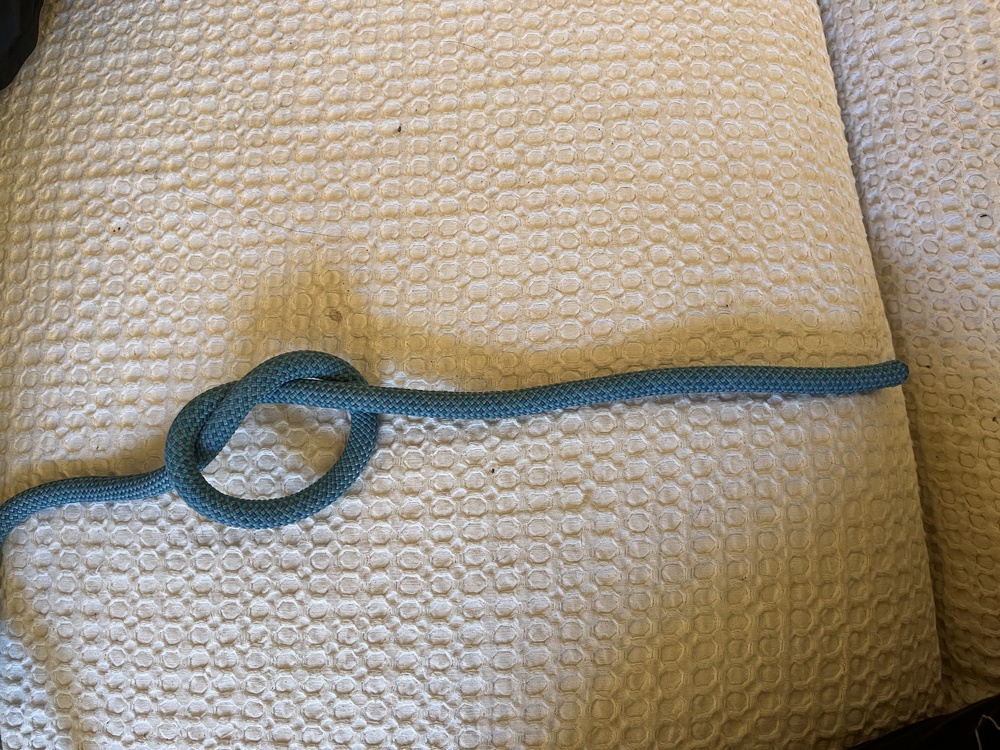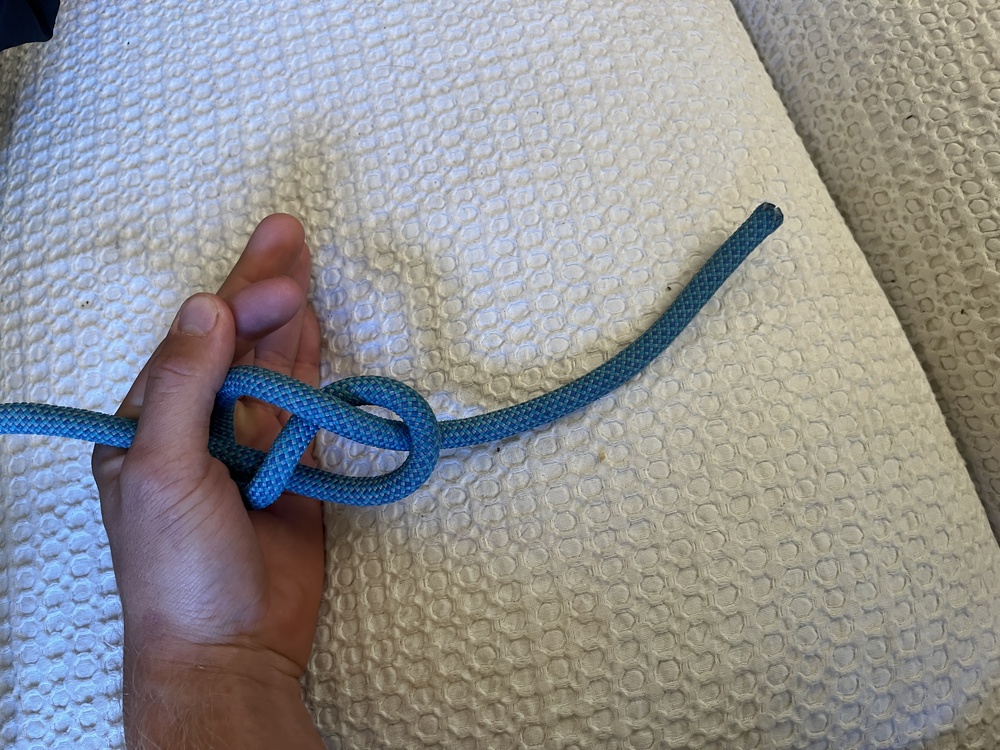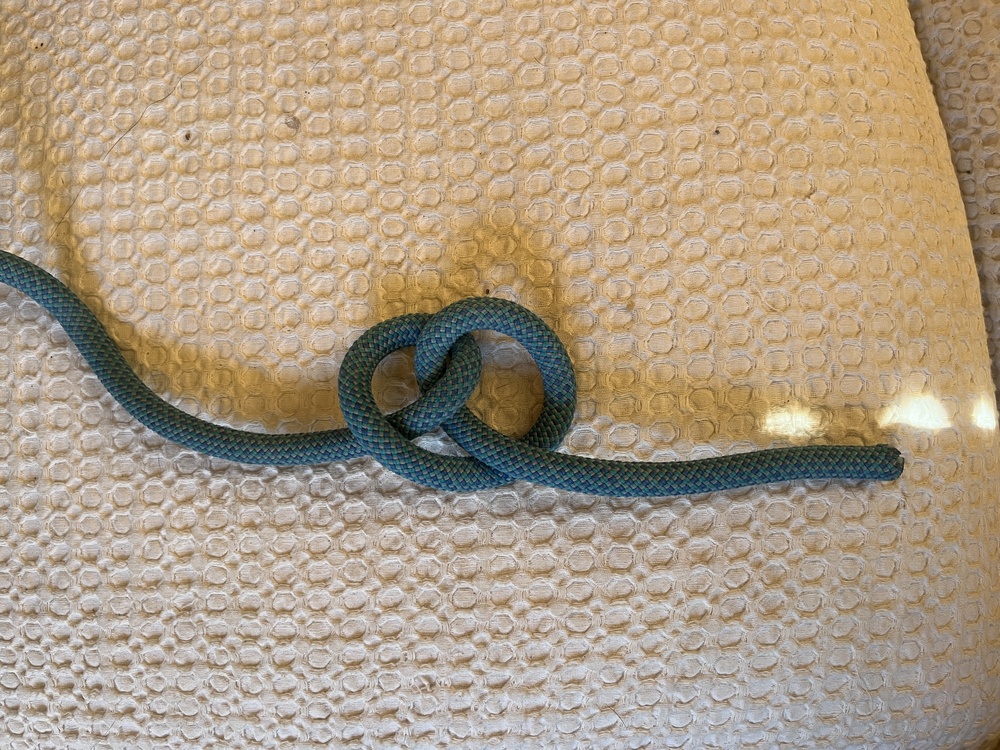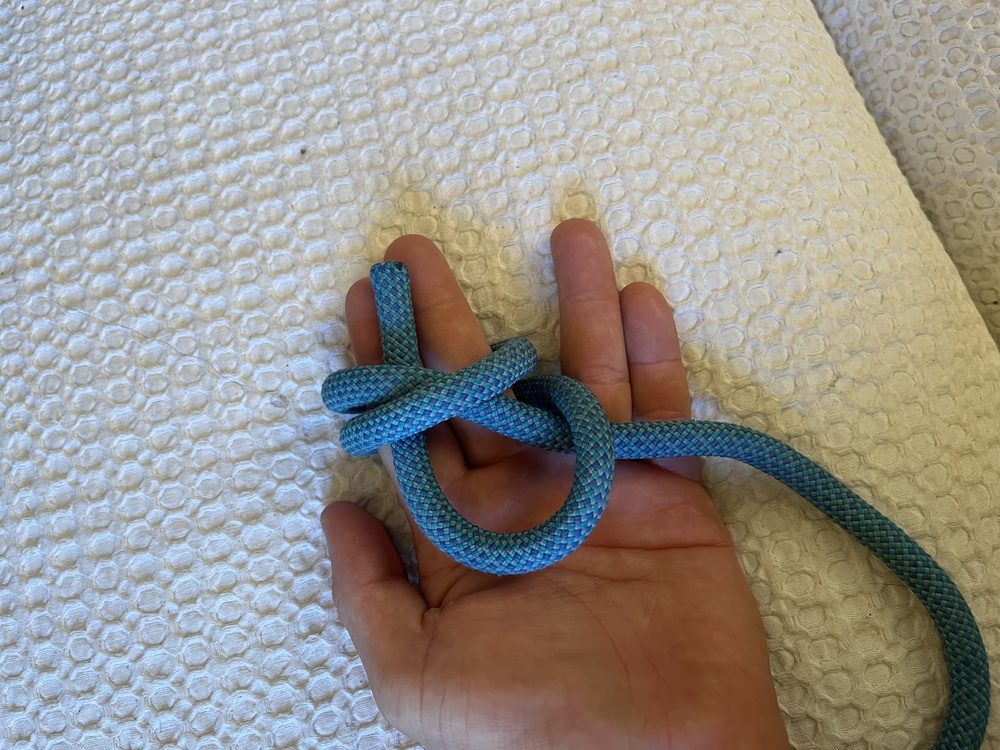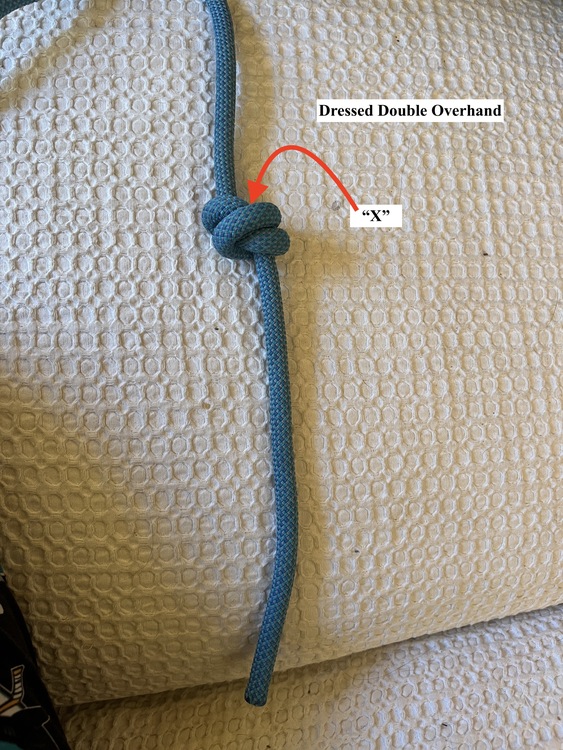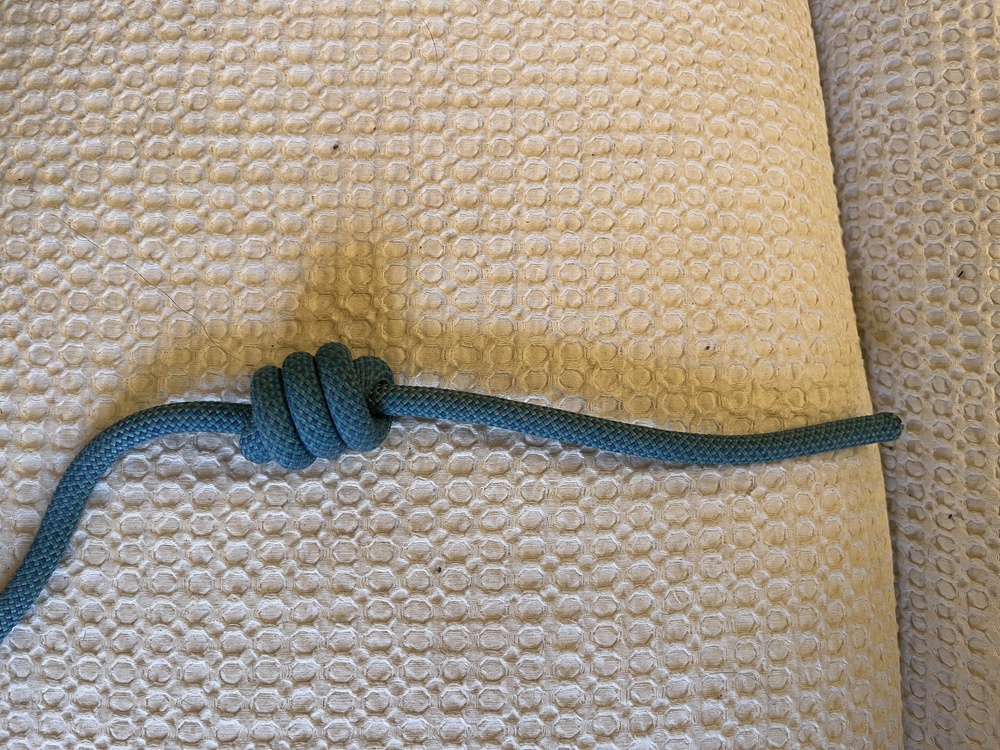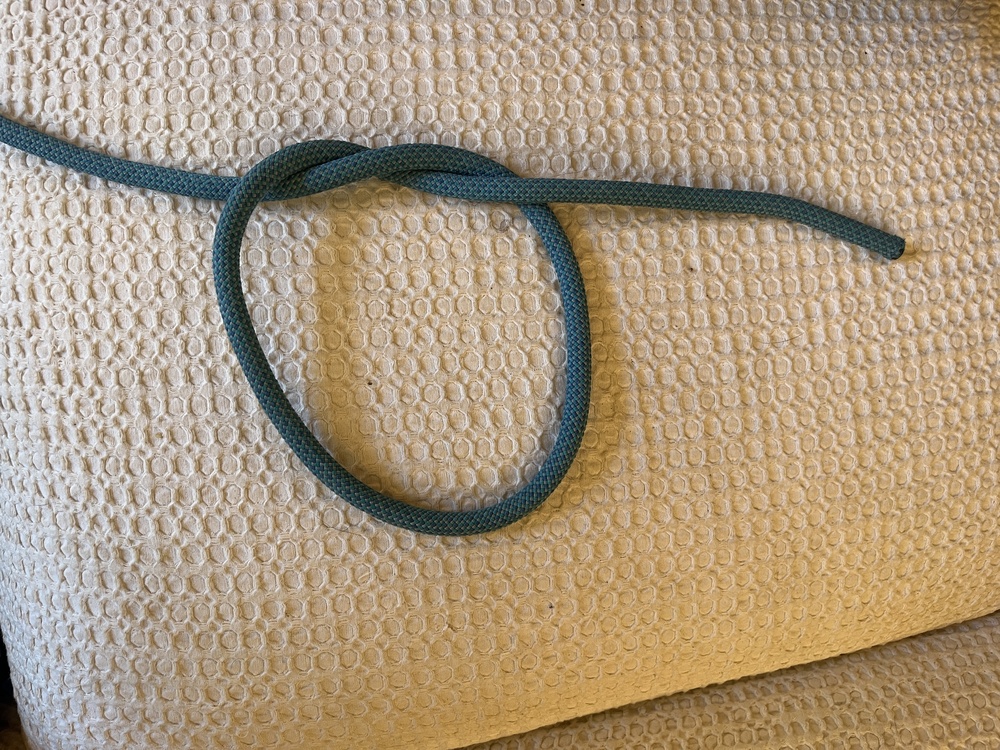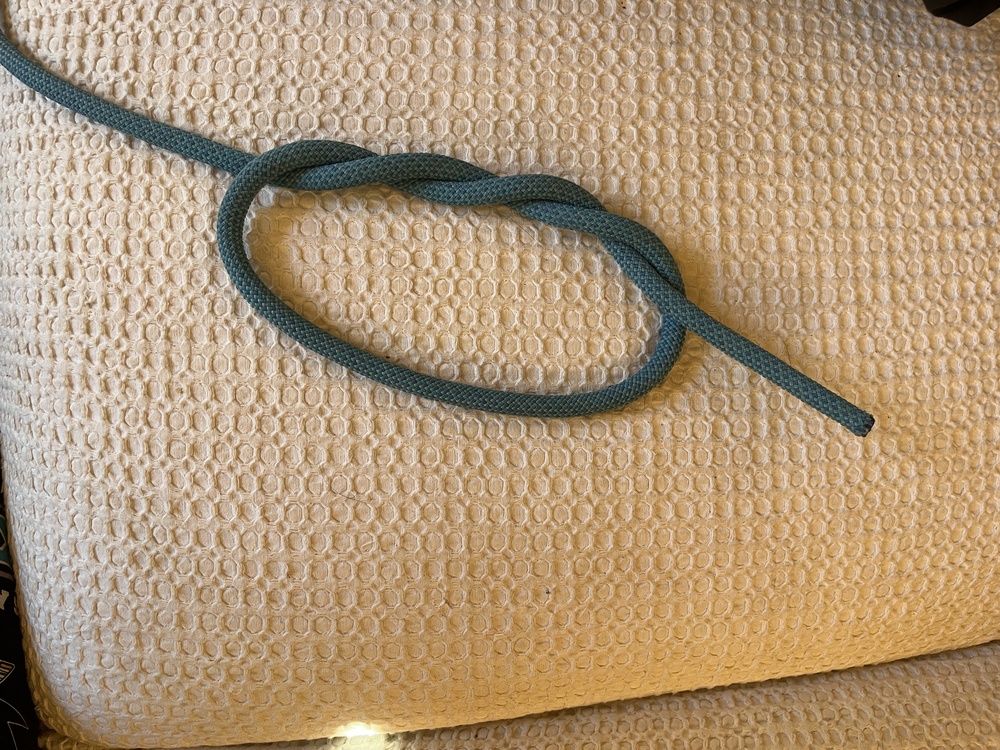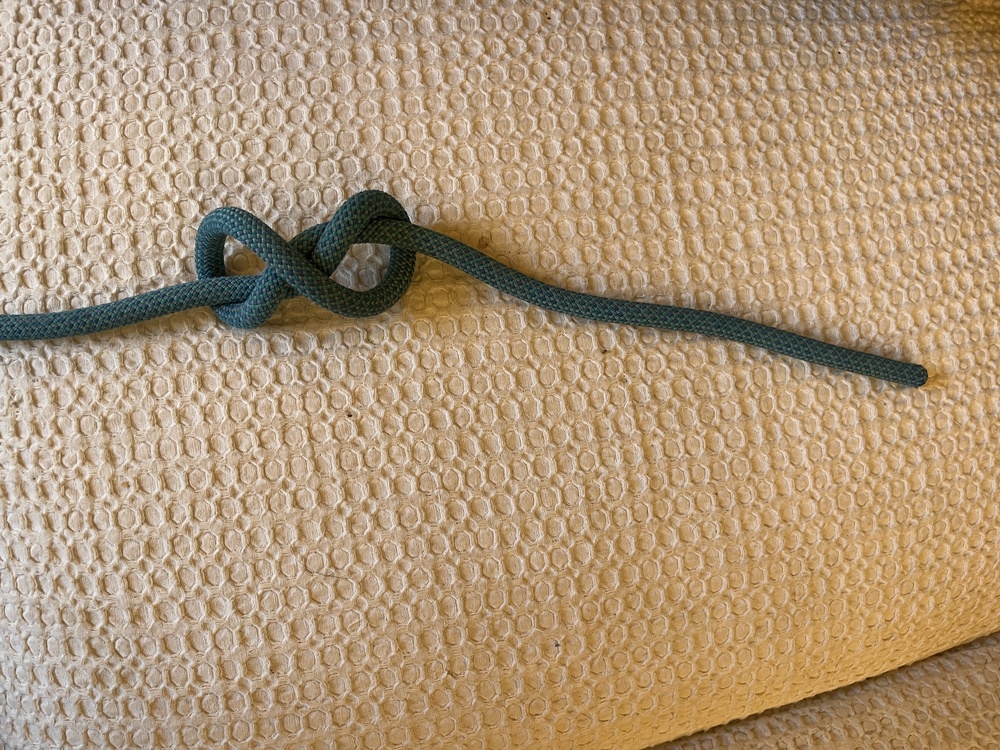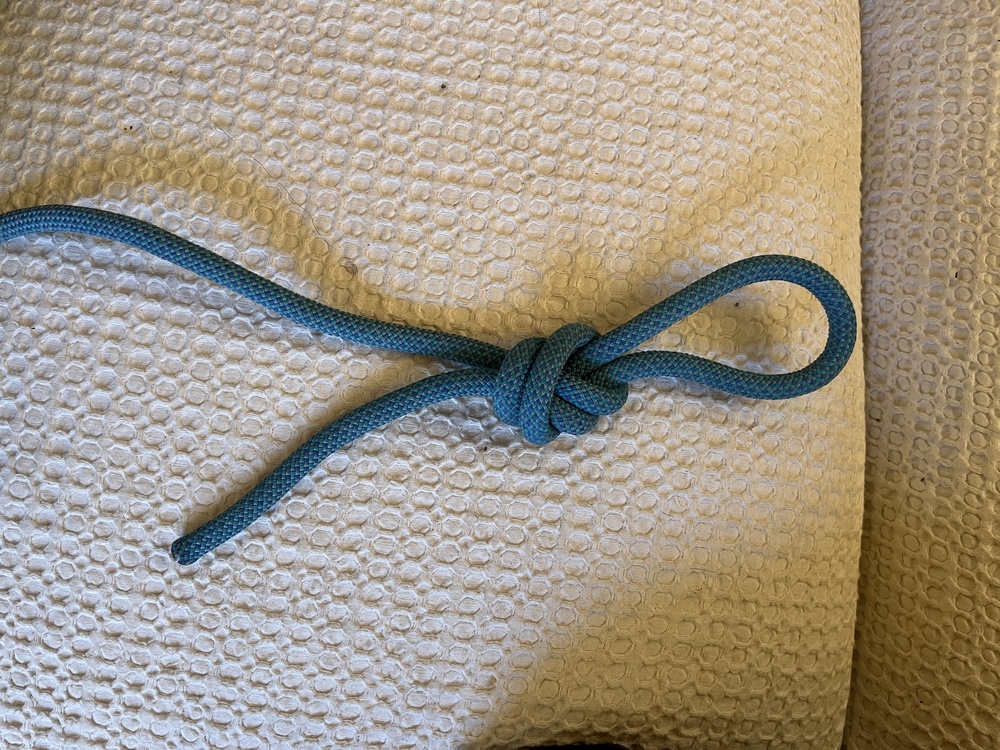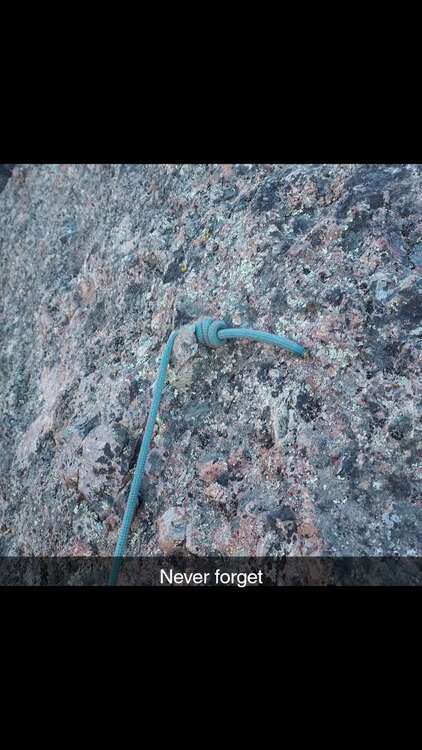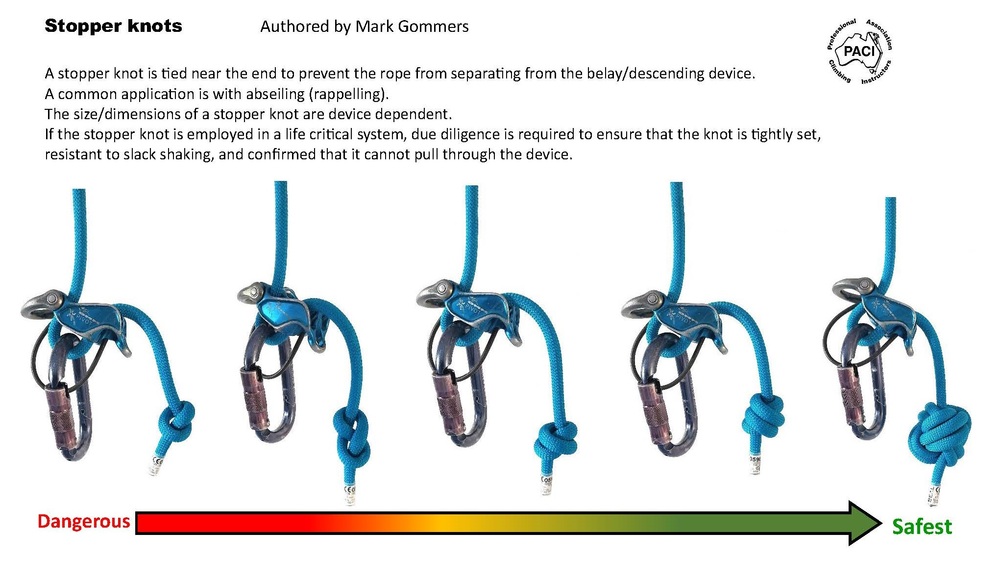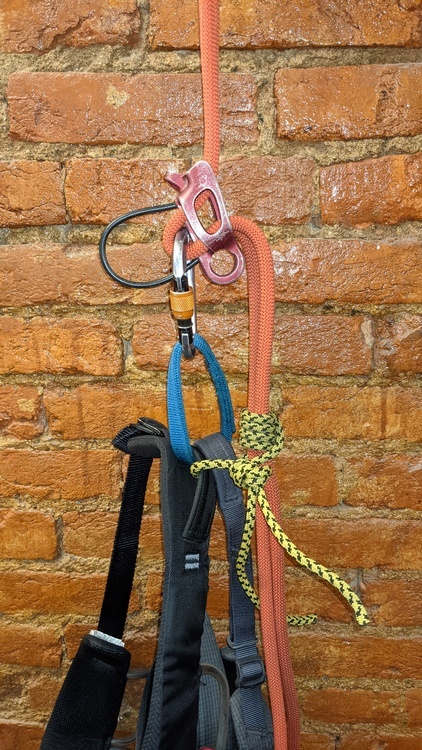"Stopper" knots coming untied on rappel/when weighted
|
|
A commenter in a recent accident thread quoted some passages from Andy Kirkpatrick, which I will requote here (I do not have access to the source text myself, so just sharing what another poster wrote). I have bolded some points of interest.
The same poster also shared the thought that the common term "stopper knot" is a bit of a misnomer in light of the above. That said, since it is a very common term and one that I'm used to using, I'm going to use it in this post. Apologies for triggering anyone :) Phylp phylp also shared her site of climbing dangers with links to other MP threads where commenters reported/surmised that knots may have come undone (I have not read these threads in depth, just scanned). Those threads:
I had never heard of knots coming undone or sheared off during a rappel until now, and am curious to learn more about this failure mode. If anyone has first hand experience with this happening, or direct knowledge from any of the three accidents linked above, please share! ___________________________ I'd like to go through the quoted passages from Kirkpatrick and what I've bolded: Overhand: This word is the one part of the passages that I disagree with, which is an intimidating thought to have considering who I'm disagreeing with! The picture below is what I know to be an overhand knot, also called a single overhand. Through my experience, education, and experimentation, I do not use a single overhand as a stopper knot for the following reasons:
Mess around with one yourself and I think you'll agree with me. Is Kirkpatrick referring to this knot, or a different one? Rolling stopper knots: a variety of different knots and forms of knots can have this failure mode. Some detractors might say "tie longer tails," which is a valid way to minimize the risk of rolling, but it's not practical on stretcher rappels and does not remove the risk of the knot rolling. Single overhand (see above) Figure 8: I actually met someone that did this. I do not use a figure 8 as a stopper knot for the following reasons:
Tie one and push down on the "top" of the knot. It will flip into a half-rolled state that looks vaguely like a pretzel. One more flip will give you a full 8 again or, more than likely, take you off the end of the rope. _________________________________________________ Rolling knots continued/double overhand: the double overhand knot (sometimes referred to mistakenly as a double fisherman's or awkwardly as half of a double fisherman's) is my gold standard for stopper knots. I know that many other people use it as well, and that is taught quite frequently, but it has a significant drawback: the knot behaves quite differently when it is dressed vs. undressed. I learned to tie this knot around my first two fingers, which I think is a very common way for people to learn how to tie it. However, this technique requires nuance, which is something often skipped over or not properly emphasized during instruction: the second wrap around your fingers should be closer to your wrist and the tail must go through both loops starting closer to your wrist. If instead the second wrap is closer to the tips of your fingers with the same threading of the tail, the resulting knot will be an undressed double overhand. This version of the knot is distinctively awkward looking to the trained eye, but beginners can have difficulty seeing the difference. An undressed double overhand introduces the following risks:
I see sooooo many people, both at the gym and at the crag, that tie the undressed version, and most of them don't even know there's a difference let alone any of the drawbacks. Could this undressed version be to blame for the three accidents linked above? Luckily the "naked" double overhand can be easily dressed by moving one of the loops up and over the other until the dressed version's distinctive "X" can be seen. I like using a dressed double overhand for the following reasons:
Since beginners can struggle with consistently tying a dressed double overhand with the around the fingers method, I prefer this method. 1) If this is a single overhand (tail goes through loop once) 2) Then this is a double overhand (tail goes through loop twice) This method is much easier, conceptually, for a beginner to understand, and it ties the dressed version most of the time. However, it does cause some kinking/twisting of the rope and may require some cleaning up/dressing. _________________________________________________ Knot shearing: I've never heard of this happening, and it seems like it would be difficult to do, but I definitely see how it's possible in the right circumstances (thin or worn rope, worn down tube style device with sharp edges. Does anyone have any knowledge of this failure mode or something close it actually happening? Wild! Something on a bight/clipped to your harness: Kirkpatrick suggests clipping the end of your harness to prevent the knot from passing through a descender such as a figure 8 plate. Another commenter in the Devil's Tower thread also mentioned that Mikey Schaefer has shared in other threads the same technique. I really like this technique for the following reasons:
I would never tie a something on a bight and NOT clip it to my harness for the following reasons:
Overhand on a bight (probably the easiest version to tie) pictured here: Actual role as a hand stop: This is a great point by Kirkpatrick, which I would guess some people don't even consider. The wrong perspective could lead someone to treat their stopper knot as an immovable object. Not to stop a plummeting climber that has lost control: In light of using the knot as a hand stop/indicator that you're end of the rope, sure, this isn't the only role of the knot, but I would wager that most climbers consider it to be the primary purpose of the knot. Changing everyone's mind is out, so instead, we should teach and use knots that are best suited to stop a plummeting climber. None of these [techniques] are a guarantee [to stop you from killing yourself]: people and brains stop climber deaths, so think through everything you do, ideally out loud. Be a Japanese train conductor, point and call! ____________________________ TLDR:
|
|
|
Great resource: Animated Knots https://www.animatedknots.com/climbing-knots ———— The name I’m familiar with is “double over hand stopper knot”. Takes about the same amount of time to tie as to spell. I tie one every-time in the gym too, keeps me in practice and shows basics to beginners thus allowing them to comfortably ask questions. If I don’t tie the double overhand stopper knot at the gym I do tie some other knot to use as a gym stopper and knot practice (butterfly, bowlin, double bowlin, figure 8 on a bight and bunny ears variation, overhand on a bight) ————— David Coley and Andy Kirkpatrick “Multipitchclimbing.com” http://people.bath.ac.uk/dac33/high/index.htm Andy Kirkpatrick’s book “Down” is worth buying. ————— I tend to tie a triple overhand, may not prevent a knot shearing event but certainly makes me feel better. I follow the situational school of action. ————— Rich Carlson, Canyons & Crags another wonderful resource https://canyonsandcrags.com/about/ -———— |
|
|
In that Devil's Tower thread, Slim wrote: "the tough thing with using knots in the ends of your rope at DT is that the rope is constantly wanting to get stuck in all of the cracks. most of the time with a bit of patience you can deal with this while you are rapping, but if it is windy at all it can be problematic. i remember rapping once and my partner tossed the rope just as a blast of wind hit us. the rope went dead sideways and it was complete clusterfuck. you can stack the rope for each rappel to avoid throwing it, but that really slows things down. one thing i always try to remember is that usually if it is getting dark it is better to slow down and be careful than to try to rush to beat the sunset. RIP to the climber." I often do not put knots in the ends of my ropes for the reasons he stated (wind, knot getting stuck in cracks or wrapping around features). This can be a real issue in places like Red Rock. I know a lot of people think this is stupid but for me the practice of knotting the ends is situational. Sometimes I want them, other times I avoid them. I use a Gigajul so I have a brake assist for the rap, I have thread tied in my rope middles so I can set it by feel rather than rely on a visual, and I often use a longer than "neccessary" rope rather than having "just enough" to get down. I'm using an 80 a lot more lately for places where I know there are rope stretchers. And as you stated, there is no replacement for vigilance. I always always always am looking at the ends of my ropes as I go down. |
|
|
phylp phylp wrote: Thanks for bringing that up! I saw his comment, but already wrote so much didn’t want to add more lol. Both of you make good points, and my counter would be that tying something on a bight and clipping it to yourself removes the risk of the knot getting stuck. If you’re concerned about wind, saddle bag, and at that point, you’ve taken the time to saddle bag you might as well tie a knot, ideally one that clips to you as well. Ultimately, it is a personal/partnership choice, although the example of someone fucking up and landing on a person below could challenge that a bit. Teaching critical thinking isn’t an easy task though :P |
|
|
phylp phylp wrote: I used to not tie knots for just this reason. I have, instead, taken to tie a knot, then clipping the knot to my harness. I find this has all the advantages of a knot (don't rap off end of rope), gives better control of the ends of the rope -- the knot doesn't get stuck in cracks. Leaves far less of the rope to be blowing around. At, if there is anyone below me, generally results in them not getting a big pile of rope falling onto them at moderate speed -- the rope generally reaches the ground/next belay/rappel at rappel speed, not gravity speed. So, this has become my general practice. |
|
|
I’m also of the old school don’t tie knots cause they get stuck, but as of lately I’ve been playing hooky. Practice with saddle bags and it doesn’t take much longer than flaking the rope to throw it. And if you throw and have to stop mid rappel to rethrow, then the saddle bag just became faster. Only saddle bag the bottom 20 meters of each side, the first 10-15m is easy to deal with. When debating the issue it seems relevant to state that no one has died BECAUSE they saddle bagged the rope. |
|
|
Greg R wrote: Carrying the rope coiled in the rapellers lap was likely a significant contributor in the sequence of events leading to the death described in this accident report - https://www.climbingyosemite.com/portfolio/accident-report-rappelling-middle-cathedral-rock/ |
|
|
Here’s a very simple, generally applicable rule: always close the system. So many fatal accidents have been caused by the end of a rope slipping through a belay/rappel device. A closed system prevents this. On rappel, tie knots in the end of your rope. It’s not rocket science. There is this strain of contrarianism in climbing, which leads to a lot of “ackchyually” tsk-tsking from a small minority of us. At the risk of psychoanalyzing a bit, climbing surely attracts people prone to thinking different, and these people are vastly overrepresented on this Internet forum. I’ve frankly never had a climbing partner who didn’t want to tie knots in the ends of the rope on a rappel, over a 25-year climbing career.
|
|
|
Dave, thanks for sharing that accident report. I found the source text for the Kirkpatrick passages in the OP: https://www.andy-kirkpatrick.com/blog/view/stopper-knots There's some good clarification in there as he talks about the problems of a single overhand. He also lists other knots you can use and techniques you can use to minimize risk to yourself. He refers to a figure 8 bight knot, which looks like what I've heard called an in-line figure 8 and animated knots calls a figure 8 directional loop. Also the oysterman knot seems like a good choice once your brain decides it's easy to tie with practice. For those that don't like to tie knots or are looking for alternative methods, definitely read the sections entitled:
|
|
|
|
|
|
also, a good stopper knot will never come undone. no matter how many microtraxs your group had. Pinnacles NP. |
|
|
Connor Freefall wrote: Rookie pins mistake. Should have relocated this hold on the way down. |
|
|
dave dave wrote: Going to disagree with this 100%. The desire to blame something (a process, an inanimate object, another person) other than the person who massively effed up. Things aren’t always set up rosy and perfect for us. We have to be able to handle evolving and dynamic situations/environments, including taking significant *extra* care when we change our rap setups. I understand it may not be the intent of the report author or dave the poster, but often times I think it’s liable to breed complacency when people can say “oh it was because of this particular thing” instead of recognizing that it is 100% a massive human error, one that is not excusable or acceptable on rappel. Point of my post? I can afford to fuck up while climbing, provided I have a good, attentive belayer and/or decent gear. I can *never* afford to fuck up on rap, period. I wonder if this concept needs to be impressed more stringently upon newer climbers, bc I seem to keep reading these reports on very preventable injuries/deaths. |
|
|
Christian Hesch wrote: Very much agree. This may sound callous but when people rap off the end of their ropes, it is 100% their fault and avoidable. It is 100% their own (stupid) decision to not close the system in some way. I think when people make excuses when accidents happen, like in the recent DT accident, that "ropes get stuck" just perpetuates this notion that this risk is completely out of your hands to mitigate. |
|
|
Christian Hesch wrote: Rappelling has been a major cause of fatalities basically since the technique began to be used, and, all too frequently, the victims have been highly experienced climbers--old timers will recall Yosemite climbers JIm Baldwin and Jim Madsen as examples. As said above, it is crucial to never become complacent, no matter how often you have rapped in the past. Even with knotted ends and 'third hands' , it is essential to check EVERYTHING and then check again. Also, I think going slow and steady, and always keeping an eye on the ends, ends up being faster, especially on multiple raps, than 'speeding' down the ropes. |
|
|
One has to be at the highest situational awareness on every rappel. Without it the knot will never save you |
|
|
Alan Rubin wrote: Jim Baldwin was killed when he got off rappel on a ledge and the haul bag he was rapping with fell off the ledge and dragged him off with it. (In those days people had not yet adopted the practice of attaching the haul bag to the rap device; instead, they hung it off their swami belts). Jim Madsen was killed rapping on El Cap (as part of a rescue) when whatever stopper knot he tied went right through his carabiner brake setup. No loss of control was involved, he intended to rap until the stopper knot jammed in his carabiner brake system and then set up a new rap anchor. At the beginning of my climbing career, we were still using the Dulfersitz, although we soon transitioned to the Swiss seat and later carabiner brakes. There was no third-hand backup and no one that I knew or heard of knotted the ends of their ropes. Rappelling was scary and we were very attentive! But the amount of rappelling we did was exponentially less. Now the majority of climbs end with rappels and so the exposure to rappelling risks has hugely increased, At the same time, better equipment and improved safety protocols have reduced the risk but also the attentiveness. I've seen people tie loose overhands and figure-eights with short ends as well, knots I think would almost certainly roll off the end of the rope under a big load. (I redid those knots.) I doubt a barrel knot with a 1- or 2-foot tail would roll off the rope's end. Interestingly, no one has tested this. I got ropes with knots at the end stuck below the rap station at Red Rocks, making it impossible to pull the rappel. Rappelling to the very end and unjamming the knots and prusiking back up was scary and consumed a lot of time (including all the remaining daylight). I also had a nasty experience in which thrown ropes with knotted ends went into a tree and got stuck. We couldn't pull them out from the rap station and so I tried rapping down, hoping to get in a better position to free them. But the tree grew out from the rock and I couldn't get near the jam; one of the ropes had jammed in a narrow crook and wouldn't come out. I eventually had to continue rappelling, well below the stuck knots, to the base of the tree and then climb the tree, reeling the rap lines back in but still facing a nasty pendulum back to the cliff if I fell out of the tree. When I finally unstuck the ends I opted for that pendulum and it was worse than I expected. I don't have much luck with saddlebagging, unless I very methodically flake the ropes with loops of decreasing length. This takes some time, but if I don't do it I not infrequently end up with bad tangles. Clipping the rope to the harness seems to me like the best of mostly not-great options. The ropes will, in many cases, get twisted and kinked, and the rappeller will have to stop and unwind the mess, unclipping the ends in the process and then reclipping them. In order to facilitate this, the ropes should be separately clipped to the harness rather than being tied together. An interesting option for both rappelling and belaying is the Edelrid Tillit. For places like Devil's Tower and Red Rocks it might be well worth it.
|
|
|
|
|
|
Andy Kirkpatrick’s recommendations change over time as he learns more. If you pick up Down, he highly recommends clove hitching the rope to yourself. For many rappels, you have fewer rope snarl issues, and you can’t lose the knots in a tree or flake a long way away. Plus, if you’re doing traversing raps and drop an end, it doesn’t have a knot in it after you drop it, so you can still pull the other end without issue. You also drop half as much rope on the unsuspecting gumbies below you in Red Rock. Pretty much a win all around. |
|
|
rgold wrote: For canyoneering, rope bags are fashionable, despite not being super vital outside of high flow whitewater stuff. Australian canyons are technically very easy, but people go over to NZ to do a technical whitewater canyoneering course, and enjoy showing off a bit when they get back. That one time we did our big wall gumby trip, we had the Supertopo aid climbing book, and IIRC it recommended using canvas shopping bags as rope bags which we dutifully tried. It must have worked well enough, as I don't remember anything about it, so it was clearly a looooong way down the list of clusters on that climb. Would love to try the Edelrid Tillit, a well-designed lightweight and packable rope bag could be a secret weapon. |
|
|
Doctor Drake wrote: Re: don't tie ropes together: The inability for the rope to unwind as you rappel is a small price to pay for the simplicity and effectiveness of tying the ropes together (overhand, in my case). I've been doing it this way and never had a problem - the rope can untwist when you pull it, but there shouldn't be twists in the first place if you're using a tuber. I also just don't throw the ropes, I lower them as I'm finding the midpoint. If they get hung up i correct on the way down As a bonus, you might not deck if you forget to clip a strand. Another bonus: impossible to forget to unite a stopper knot before you pull the rope - you untie one you untie both. I always use a backup, a helical knot tied through the tie-in points below the belay device (not extended): |

 Continue with onX Maps
Continue with onX Maps Sign in with Facebook
Sign in with Facebook




















